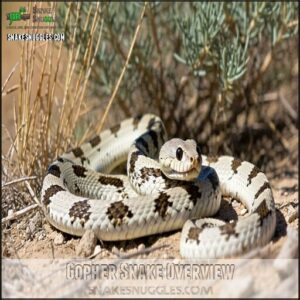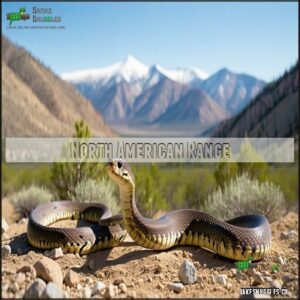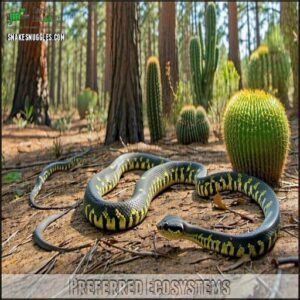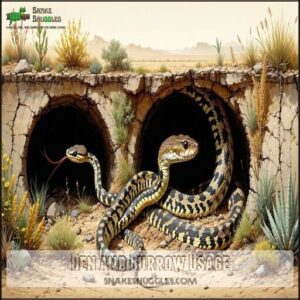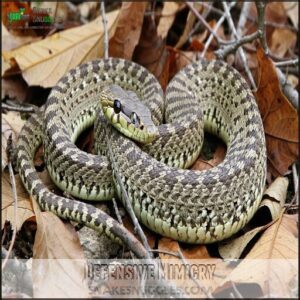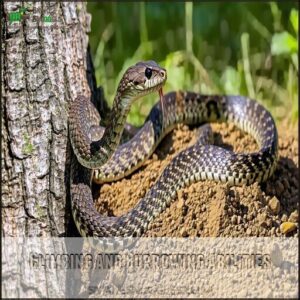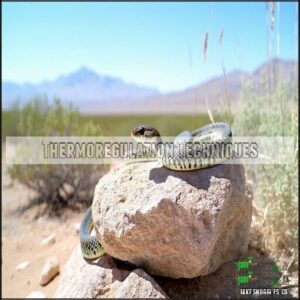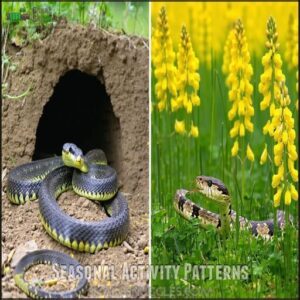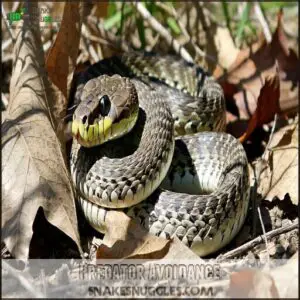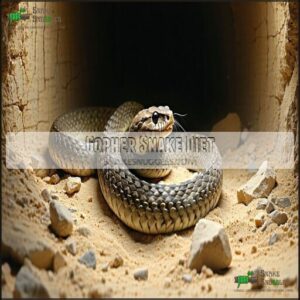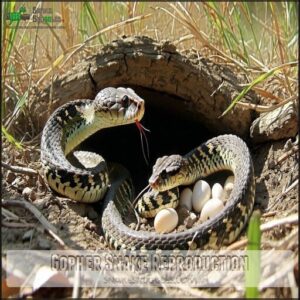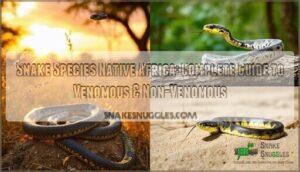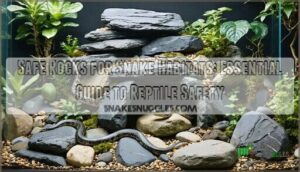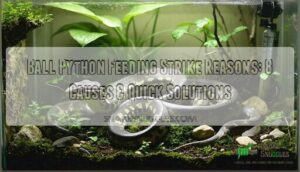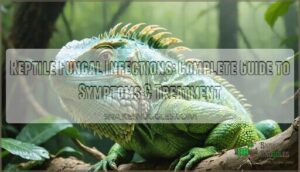This site is supported by our readers. We may earn a commission, at no cost to you, if you purchase through links.
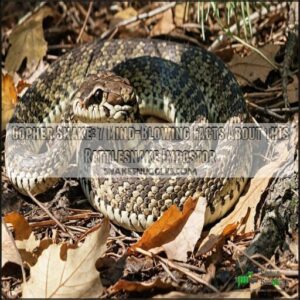 You’ll find gopher snakes throughout North America, reaching up to 7 feet long with distinctive blotched patterns.
You’ll find gopher snakes throughout North America, reaching up to 7 feet long with distinctive blotched patterns.
Despite their intimidating size, they’re non-venomous constrictors that help control rodent populations—hence their name.
When threatened, these clever reptiles mimic rattlesnakes by flattening their heads, hissing loudly, and vibrating their tails against dry leaves.
They’re excellent climbers and burrowers, adapting to diverse habitats from deserts to grasslands.
You can distinguish them from dangerous lookalikes by their pointed tails and round pupils.
Understanding their defense mechanisms reveals nature’s fascinating evolutionary solutions to survival challenges.
Table Of Contents
- Key Takeaways
- Gopher Snake Overview
- Gopher Snake Habitat
- Gopher Snake Behavior
- Gopher Snake Diet
- Gopher Snake Reproduction
- Frequently Asked Questions (FAQs)
- How poisonous is a gopher snake?
- Are gopher snakes good to have in your yard?
- What happens if you get bit by a gopher snake?
- What do you do if you see a gopher snake?
- What time of day do gopher snakes come out?
- Is it good to have gopher snakes in your yard?
- How to tell if it’s a gopher snake?
- What is a common name for a gopher snake?
- Are gopher snakes venomous?
- What is a Pacific gopher snake?
- Conclusion
Key Takeaways
- You’ll find gopher snakes across North America, where they serve as nature’s pest control experts by consuming up to 75% of their diet in rodents, helping maintain balanced ecosystems without chemicals.
- You can identify these non-venomous constrictors by their cream to light brown coloring with dark blotches, pointed tails, round pupils, and their unique ability to mimic rattlesnakes with convincing defensive displays.
- You’ll typically spot these adaptable reptiles during daylight hours in diverse habitats from deserts to grasslands, where they spend up to 90% of their time in underground burrows and dens.
- You’re completely safe around gopher snakes since they’re non-venomous – if bitten, simply clean the wound with soap and water, proving these misunderstood reptiles deserve protection rather than fear.
Gopher Snake Overview
You’ll find gopher snakes throughout western North America, where these nonvenomous reptiles grow 3-7 feet long with distinctive pale coloration and dark patterns that often lead to mistaken identification as rattlesnakes.
They’re excellent climbers and burrowers with large eyes and narrow necks, helping them hunt rodents effectively while maintaining small territories of less than a quarter mile, which is a key factor in their ability to hunt rodents.
Scientific Classification
The classification of gopher snakes reveals fascinating connections in the snake world.
You’ll find these reptiles in the scientific hierarchy:
- Kingdom: Animalia, belonging to the Family Colubridae
- Genus: Pituophis, meaning "pine snake" due to habitat preferences
- Species: P. catenifer, with "catenifer" referring to chain-like markings
- Taxonomy includes six distinct subspecies, each with unique geographic variations in genetic makeup
When scientists study the phylogeny, they discover remarkable genetic variation across populations, which is a key aspect of understanding the snake world and its fascinating connections.
Physical Characteristics
The distinctive gopher snake catches your eye with its impressive physical characteristics.
You’ll recognize this rattlesnake impostor by its unique features.
| Feature | Description |
|---|---|
| Size | 3-7 feet long, slimmer than rattlesnakes |
| Coloration | Cream to light brown with dark blotches |
| Head Morphology | Large eyes, narrow neck, triangular head |
| Scale Patterns | Keeled scales with 29-37 at mid-body |
| Subspecies Differences | Color variations match local vegetation |
Geographic Range
You’ll find gopher snakes spread out across North America, from southern Canada through the western United States down into Mexico.
Their snake range covers impressive habitat altitudes, thriving from sea level up to 9,000 feet.
Different regions host six subspecies with distinct distribution patterns, including the Sonoran and Great Basin varieties.
These adaptable reptiles show remarkable urban adaptation, even extending their range overlap as climate influence alters traditional territories.
Common Names
While these reptiles roam across North America, you’ll hear different names for them everywhere you go.
The gopher snake’s regional nicknames include bullsnake, pine snake, and blow snake—a nod to their impressive hissing ability.
These snake common names often reflect local vernacular or the snake’s diet, as with "gopher snake."
Each snake subspecies carries unique etymological origins, though misidentification risks increase with this name evolution.
In Arizona, the term gophersnake is used interchangeably with bullsnake.
Distinctive Features
Six unmistakable features distinguish gopher snakes from their venomous lookalikes.
You’ll notice their large eyes and distinct head with a narrow neck. They display cream to light brown coloration with dark blotches and keeled scales that give them texture.
Their face typically shows two dark lines extending from the head around the eyes. This rattlesnake mimicry causes frequent snake misidentification, despite significant differences in scale patterns and body size between subspecies variations, which can be considered a complete concept.
Gopher Snake Habitat
You’ll find gopher snakes thriving across diverse North American landscapes, from arid deserts and prairies to woodlands and even urban gardens up to 9,000 feet in elevation.
They spend most of their time in underground burrows or dens, often repurposing abandoned rodent homes where they’ll hide for up to 90% of their lives.
North American Range
You’ll find gopher snakes across most of North America, from southern Canada to northern Mexico.
Their subspecies distribution includes the Great Basin gopher spanning from Canada to Arizona, while the Sonoran subspecies inhabits Texas to southern California.
These adaptable reptiles can thrive at altitude limits up to 9,000 feet, though they rarely live above 2,000 feet in Pacific states.
Range overlap occurs where subspecies territories meet.
Preferred Ecosystems
Once you’ve spotted these snakes across North America, you’ll notice they’re masters of habitat diversity.
Gopher snakes thrive in four distinct ecosystem types:
- Arid deserts with sparse vegetation
- Coastal dunes and grasslands with sandy soil
- Open woodlands and coniferous forests up to 9,000 feet altitude
- Shrublands and prairies with ample burrowing opportunities
Their microhabitat selection typically favors open areas over dense vegetation, where they can easily hunt rodents, showcasing their adaptability in various environments, including open woodlands.
Adaptation to Urban Environments
While gopher snakes thrive in natural settings, they’re surprisingly adaptable to urban habitats.
You’ll often spot them in suburban neighborhoods, parks, and gardens where they provide valuable rodent control. They’re among the snake species best equipped for city life, though urban sprawl has fragmented their populations and disrupted gene flow.
Conservation challenges include habitat loss and highway mortality, making their distribution changes a growing concern. These snakes play a role in controlling rodent populations, supporting ecosystem balance.
Den and Burrow Usage
While gopher snakes adapt well to human neighborhoods, they’re actually master underground architects in their natural habitats.
You’ll find these clever reptiles spending up to 90% of their time in burrows.
Their underground lifestyle includes:
- Repurposing abandoned rodent burrows rather than constructing their own
- Maintaining den temperatures between 65-85°F for ideal comfort
- Sharing burrows with other snakes during overwintering
- Using multiple entrance/exit points for predator avoidance
Gopher Snake Behavior
You’ll notice that gopher snakes employ impressive defensive behaviors, including mimicking rattlesnakes by flattening their heads, hissing loudly, and vibrating their tails when they feel threatened.
They’re primarily active during daylight hours but can switch to nighttime activity in hot weather, spending most of their time in burrows where they showcase remarkable climbing and digging abilities.
Defensive Mimicry
Where gopher snakes live directly affects their survival strategies.
When threatened, these clever reptiles employ remarkable rattlesnake mimicry to fool predators.
You’ll be amazed how they flatten their heads into triangular shapes, hiss loudly, and vibrate their tails against dry leaves to simulate a rattle.
This Batesian mimicry creates a convincing bluffing tactic that makes potential threats think twice before attacking.
Their defensive posture is so effective that many humans mistake them for venomous species, due to their impressive mimicry.
Climbing and Burrowing Abilities
While they use defensive mimicry to fool predators, gopher snakes are also masters of movement.
You’ll be amazed at their climbing speed as they scale trees and fences with surprising agility.
Their arboreal adaptations allow them to access bird nests for eggs and young.
Underground, their burrowing techniques are equally impressive – they’ll excavate their own homes or modify existing burrows.
For assistance with this, specialized snake habitat products can be useful, showcasing their incredible substrate preference and adaptive snake behavior.
Thermoregulation Techniques
While being cold-blooded creatures, gopher snakes have developed remarkable temperature regulation strategies to maintain ideal body functions.
Their thermoregulation techniques include:
- Basking behavior on rocks or open ground to absorb solar heat
- Retreating to burrows during extreme temperatures
- Adopting crepuscular activity patterns in desert habitats
- Making strategic habitat selections based on available thermal gradients
You’ll often spot these clever reptiles warming up in the morning sun before starting their daily hunting activities.
Many owners supply basking platform options for their snakes, which is an important part of their temperature regulation and overall care.
Seasonal Activity Patterns
While these reptiles embrace brumation habits during winter months, you’ll find their activity peaks during spring and summer.
Gopher snakes are primarily diurnal, hunting when the sun warms their bodies, though they become crepuscular in hot desert regions.
Temperature influence dictates their behavior—they’ll snake hibernation in cold months and emerge to snake sun and warm up when prey availability increases.
Their mating season typically occurs after spring emergence. They also use tail movements to deter threats.
Predator Avoidance
When threatened out in the open, gopher snakes rely on remarkable mimicry effectiveness to survive.
They’ll flatten their heads into triangular shapes and vigorously shake their tails against dry leaves, creating a rattlesnake-like sound.
Their defensive traits also include burrowing escape, vigilance behavior, and scent masking.
You’ll notice snake defense mechanisms vary based on the predator—they’ll either flee quickly or stand their ground with impressive snake defensive displays.
Gopher Snake Diet
You’ll find these resourceful hunters consuming a varied menu of rodents, lizards, birds, and eggs, using their powerful constriction method to subdue prey before swallowing it whole.
They’re nature’s most efficient pest controllers, entering underground burrows to capture gophers and mice that would otherwise damage crops and gardens, making them efficient controllers of pests.
Primary Prey Species
While gopher snakes put on impressive defensive displays, their hunting prowess truly shines through their diet.
You’ll find these efficient predators primarily targeting rodents—mice, rats, and their namesake gophers top the snake diet menu.
They don’t stop there though; their prey selection extends to birds, lizards, and even eggs.
Younger gopher snakes often tackle smaller meals like insects before graduating to more substantial rodent control duties.
Constriction Method
Unlike venomous rattlesnakes that use toxins, when a gopher snake captures prey, it employs impressive muscle strength to wrap its body around victims.
You’ll find these skilled constrictors quickly coiling around rodents, cutting off blood flow rather than air.
Their constriction speed is remarkable—tightening with each exhale of their prey, which guarantees prey suffocation before the snake begins its slow digestive process, accommodating various prey sizes.
Meeting their calcium to phosphorus ratio needs involves securing proper digestion.
Foraging Strategies
While constriction overpowers prey, these clever hunters excel at finding meals in the first place.
You’ll find gopher snakes actively searching for snake prey rather than ambushing. They use their exceptional sense of smell to track rodents into burrows, flicking their tongues to "taste" the air.
Their hunting time typically peaks during daylight hours, though they’ll pursue snake lizards, snake frogs, and snake small snakes whenever opportunity strikes, making them successful at finding a variety of prey with their clever hunting tactics.
Role in Pest Control
The humble gopher snake serves as nature’s exterminator on farms and in gardens.
You’ll find these natural predators substantially reducing rodent populations wherever they live.
Farmers often welcome their presence for agricultural benefits, as one snake can consume dozens of mice and gophers annually.
Their ecosystem impact extends beyond mere pest control—they maintain balanced rodent numbers without chemicals, making them champions of sustainable pest management, and providing agricultural benefits.
Food Sources and Availability
Seasonally, these impressive hunters adjust their diet based on available prey throughout the year.
Your local rodent populations form about 75% of their menu, with birds (8%), eggs (12%), and lizards (3%) completing their food options.
Their hunting success depends on prey size and availability—younger snakes target smaller food like insects, while adults tackle larger rodents and birds.
Diet variation occurs naturally across different geographic regions, and this variation is based on available prey.
Gopher Snake Reproduction
You’ll find that gopher snakes are oviparous reptiles, laying clutches of 2-8 eggs typically during the summer months of June and July.
During breeding season, these resourceful reptiles engage in complex mating rituals before females select protected locations like abandoned burrows or rotting logs to deposit their precious eggs, which is a crucial part of their breeding season.
Mating Season and Rituals
In spring, gopher snakes kick off their reproductive cycle with dramatic courtship rituals you won’t soon forget.
Males engage in wrestling matches, entwining their bodies while hissing loudly to win breeding rights.
During mating season, females release special skin secretions that signal their readiness to mate.
Males line up alongside females and may even gently bite their necks during courtship behavior to establish a connection, which is a crucial part of their reproductive cycle.
Egg-Laying Process
After successful mating, female gopher snakes find secluded spots for their eggs.
Female gopher snakes carefully select hidden, moisture-rich spots to lay their eggs, ensuring the perfect environment for hatchling development.
You’ll notice they’re oviparous reptiles, laying clutches of 2-8 leathery eggs in protected areas like rotting logs, abandoned rodent burrows, or compost piles.
The mother carefully selects nest sites with ideal moisture and temperature conditions, though parental care ends after egg-laying.
Snake eggs have porous, flexible shells that allow oxygen exchange while protecting the developing hatchlings inside.
Incubation Period
The ticking clock of egg development begins once these oviparous snakes deposit their clutches.
You’ll find temperature dramatically affects incubation periods, typically lasting 65-75 days.
Warmer nests speed egg development while cooler conditions extend incubation time.
Notably, temperature doesn’t just affect hatching success—snake eggs incubated at 26-28°C produce hatchlings that emerge earlier and move faster than those from higher or lower temperatures, giving them a survival edge in the wild, with faster movement.
Hatchling Care
After the eggs have fully developed, gopher snake hatchlings emerge ready for independence. Unlike some reptiles, mother gopher snakes provide no maternal care once eggs hatch outside their body.
Young snakes are completely self-sufficient from birth, equipped with instincts to:
- Hunt small prey immediately
- Find suitable shelter independently
- Regulate their own body temperature
- Defend themselves from predators
- Navigate their environment without guidance
Snake hatchlings quickly disperse from nest sites, avoiding cannibalism from adults including their own parents. Owners should research suitable tank sizes to confirm the hatchlings have enough space to ensure their survival and growth.
Lifespan and Growth Rate
Gopher snakes’ robust growth pattern contributes to their impressive lifespan of 12-15 years in the wild, with some captive specimens reaching 33 years.
You’ll notice these reptiles grow rapidly during their first three years before their development slows considerably.
| Growth Stage | Size | Maturity Timeline |
|---|---|---|
| Hatchling | 12-14 inches | Newborn |
| Young Adult | 3-5 feet | Males: 1.5 years, Females: 4 years |
| Full Adult | 3-7+ feet | Complete growth by year 5-6 |
Frequently Asked Questions (FAQs)
How poisonous is a gopher snake?
You’re completely safe from any toxic threat.
Gopher snakes aren’t poisonous or venomous at all.
They kill prey through constriction rather than venom, making them harmless to humans despite their intimidating defensive displays.
Are gopher snakes good to have in your yard?
Like guardian angels of your garden, these non-venomous reptiles are excellent to have around.
They’ll control rodent populations naturally, pose no threat to humans, and help maintain ecological balance in your yard’s ecosystem.
What happens if you get bit by a gopher snake?
Your bite will cause minor pain and slight bleeding since they’re non-venomous.
You’ll need to clean the wound thoroughly with soap and water, then apply antiseptic to prevent infection.
No medical attention is typically required.
What do you do if you see a gopher snake?
When you encounter one, remain calm and keep your distance.
Don’t make sudden movements or try to handle it. These beneficial predators control rodent populations naturally.
Simply back away slowly and let it continue on its way, as they are natural controllers of the environment.
What time of day do gopher snakes come out?
As regular as clockwork, these reptiles emerge during daylight hours.
You’ll typically spot them basking in morning sun, then hunting throughout the day.
They’re sometimes active after sunset during hot weather.
Is it good to have gopher snakes in your yard?
Yes, it’s beneficial to have gopher snakes in your yard.
They’ll control rodent populations naturally, reducing pest problems.
You won’t need chemical pesticides, and they’re harmless to humans despite their intimidating appearance, making them a natural form of pest control.
How to tell if it’s a gopher snake?
You’ll recognize gopher snakes by their cream to light brown coloring with dark blotches on their backs.
They’ve narrow necks, large heads, prominent eyes, and two dark lines from their head around each eye, which are prominent eyes.
What is a common name for a gopher snake?
You might know this snake as a bull snake, blow snake, or yellow gopher snake.
They’re sometimes called pilot snakes, red gophers, or red headed snakes depending on your region and which subspecies you’ve encountered.
Are gopher snakes venomous?
No, gopher snakes are completely nonvenomous and harmless to humans.
You can identify them as constrictors that squeeze their prey rather than using venom.
Their rattlesnake-like defense behaviors mislead people about their harmless nature.
What is a Pacific gopher snake?
Like a stealthy hunter prowling through California’s grasslands, the Pacific gopher snake is your nonvenomous friend who helps control rodent populations.
You’ll find this cream-colored subspecies with dark blotches slithering through western states, reaching 3-7 feet long.
Often pretending to be their rattlesnake cousins when threatened.
Conclusion
Embracing the gopher snake’s remarkable journey reveals nature’s brilliant tapestry of survival tactics.
These master impersonators showcase how evolution crafts solutions without venom’s deadly arsenal. You’ll appreciate their essential role in ecosystem balance, from pest control champions to misunderstood neighbors.
Next time you spot a gopher snake, remember you’re witnessing a living example of adaptation and mimicry at its finest.
Their presence signals healthy habitats, reminding us that understanding, not fear, brings harmony with our scaled companions.

